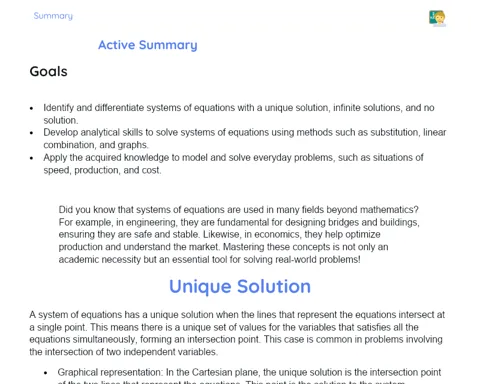Rotations in the Cartesian Plane | Active Summary
Objectives
1. 🔍 Understand and apply the concept of rotations in the Cartesian plane, focusing on 90-degree rotations around the origin.
2. 🎨 Develop spatial visualization skills and understanding of geometric transformations through hands-on and interactive activities.
Contextualization
Did you know that rotations in the Cartesian plane are more than just a math exercise? They are fundamental in fields like graphic design and animation, allowing artists and scientists to create and manipulate images digitally. For example, when rotating a 3D object in modeling software, professionals need to understand how the object's coordinates change for it to be displayed correctly. This shows that what you're learning has real-world applications and can open doors to creative and innovative careers!
Important Topics
Rotation of Figures
The rotation of figures in the Cartesian plane involves changing the position of a figure around a fixed point, called the center of rotation. In this context, we are focusing on 90-degree rotations around the origin. This transformation is fundamental for understanding how the coordinates of a point change when the figure is rotated.
-
Center of Rotation: Fixed point around which the figure is rotated. In our case, we are considering the origin of the coordinate system.
-
Angle of Rotation: Determines the amount of rotation. For a 90-degree rotation, the points (x, y) are transformed into (-y, x), which is crucial for our understanding.
-
Change in Coordinates: Understanding how the coordinates of a point change after rotation helps visualize and draw rotated figures.
Spatial Visualization
The ability to visualize objects in different positions and perspectives in space. In the context of rotations, it is essential to anticipate how a figure will change and to verify whether the transformation has been applied correctly.
-
Skill Development: Practicing rotations in the Cartesian plane helps develop spatial visualization skills that are useful in many areas, such as design, engineering, and science.
-
Importance of Practice: The more you practice, the easier it becomes to anticipate and perform rotations of geometric figures.
-
Practical Applications: Spatial visualization is crucial for activities involving modeling, such as product design and architecture.
Practical Applications
Rotations in the Cartesian plane are not just theoretical concepts; they have practical applications in various fields. For example, in engineering, it is essential for designing rotational components. In graphic design, it is used to manipulate images and create animations.
-
Engineering: Fundamental for designing rotating parts or mechanisms that involve rotational movement.
-
Graphic Design: Used to create visual effects, animations, and adjust page layouts.
-
Education and Games: Applied in educational software and games to teach geometry and for entertainment through puzzles and challenges.
Key Terms
-
Rotation: Movement of a figure around a fixed point, usually a specific angle around a center of rotation.
-
Rotation Point: The point around which the figure is rotated. In the Cartesian plane, we often refer to the origin (0,0) as the rotation point.
-
Geometric Transformation: An operation that maps a figure to another position without altering its shape or size, such as rotation, reflection, and translation.
To Reflect
-
How can the rotations of figures help solve practical problems in everyday life or in other disciplines?
-
Why is it important to understand the coordinates of a point during and after a rotation? How does this apply in real-life situations?
-
In what way can spatial visualization be an essential skill in your future career or in creative activities that interest you?
Important Conclusions
-
We explored rotations in the Cartesian plane, focusing on 90-degree rotations around the origin, and how this affects the coordinates of points.
-
We discussed the importance of spatial visualization and how it permeates various fields, from pure mathematics to practical applications in engineering and design.
-
We reinforced the idea that understanding rotations is not just an academic skill, but something with real applications that can be crucial in many careers and creative activities.
To Exercise Knowledge
- Draw a square in the Cartesian plane with vertices at (1,1), (1,3), (3,3), and (3,1). Rotate the square 90 degrees clockwise and draw the new square formed. 2. On graph paper, draw a triangle with vertices at (2,2), (4,4), and (6,2). Rotate it 90 degrees clockwise and note the coordinates of the new vertices. 3. Create an original drawing that uses rotations to create a pattern. Use at least two different geometric figures and apply 90-degree rotations.
Challenge
Imagine you are a theme park designer and need to create a new ride that involves rotated figures. Draw the layout of your new ride on the Cartesian plane and explain the rotations you applied to create each component.
Study Tips
-
Practice drawing different shapes on graph paper and applying rotations manually to better visualize the transformations.
-
Use dynamic geometry software like GeoGebra to experiment with rotations and instantly see how the figures change.
-
Discuss with your classmates or teacher about the practical applications of rotations in different fields, as this can help solidify your understanding and interest in the subject.



